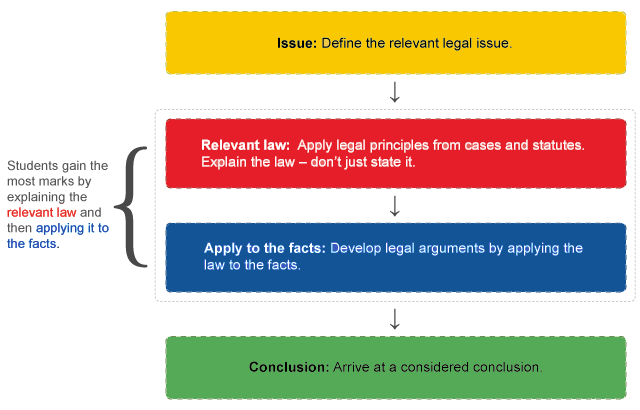Writing a legal scenario
When answering a Company Law problem, it is useful to apply the IRAC structure so that you address all areas required.
The IRAC method has four steps:
- Identify the issue
- Relevant law - Here you need to explain the law not just state it. This could be sections/s of the Corporations Act or case law
- Application to the facts - the law is applied to the facts of the problem
- Conclusion
Use the following IRAC structure as a guide to answer case study questions.

- Issue: Define the legal relevant issue.
- Relevant law: Apply legal principles from cases and statutes. Explain the law, don't just state it.
- Apply to the facts: Develop legal arguments by applying the law to the facts.
- Conclusion: Arrive at a considered conclusion.
Note: Students gain the most marks by explaining the relevant law and then applying it to the facts.
Example question and answer
Question
Bingo Ltd is a manufacturer of electrical goods. It entered into a contract with Melvin Ltd, a large discount retailer. Under this contract, Bingo Ltd was to supply its goods exclusively to Melvin Ltd. The directors of Melvin Ltd subsequently discover that a wholly-owned subsidiary of Bingo Ltd is selling identical electrical goods to competitors at cheaper prices. It appears that the subsidiary was incorporated to enable Bingo Ltd to avoid the effects of the contract with Melvin Ltd. Advise the directors.
(This a five-mark question)
Answer
| Issue | The issue in this case is whether the corporate veil can be lifted. |
| Relevant law | The legal principle to apply, established in Saloman's case is that a company is a separate legal identity from its directors and members. However, there are exceptions when the corporate veil can be lifted. In the case of Guildford Motor Co Ltd v Horne it was decided that the veil of incorporation can be lifted if a wholly owned subsidiary was set up by a company to avoid a legal obligation under contract. |
| Application to facts | In this case, it appears that Bingo Ltd set up the subsidiary company to avoid its contractual obligations to supply its goods exclusively to Melvin Ltd. |
| Conclusion | Therefore, the directors can ask the court to lift the veil of the wholly owned subsidiary of Bingo and sue Bingo for breach of contract. |
Please note: This is a simple low mark answer (5 marks) to illustrate the use of IRAC only. Many Company Law problems will involve multiple issues. In these scenarios each issue would need to be addressed. For example: The first issue is... The second issue is whether...
Activity
1. Read the following question.
2. Now read the following text and try to identify the IRAC structure. Check your understanding by clicking on the buttons to reveal the IRAC structure.
Activity
Read the following question, then identify which part of the IRAC structure best fits each text excerpt by selecting from the drop down menu.
Question
| Text | IRAC structure |
|---|---|
| The issue is whether the member is bound by a change to the constitution which requires an increase in the contribution of capital. | |
| Therefore, this member has no liability to pay the $1,500. | |
| The legal principle in the scenario is firstly that members are bound by changes in the statutory contract. However, in this case section s140(2) applies as it states that a member is not bound by any changes in the constitution unless he/she agrees in writing. | |
| Clearly, this member has not agreed in writing. |
